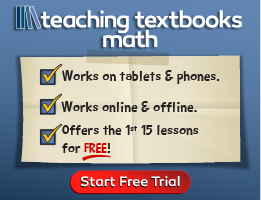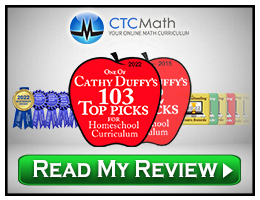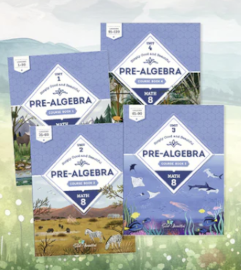Simply Good and Beautiful Pre-Algebra is designed as an eighth-grade course to follow Simply Good and Beautiful Math 7. It has four course books (titled Course Book 1, Course Book 2, etc.), an Answers & Solutions book, and free videos. The Course Books each have about 200 pages—lots of content! The optional PDF of Pre-Algebra Extra Practice Worksheets provides more practice for most lessons and comes with its own free Answers & Solutions book.
The course is designed for independent work and for use by a non-denominational Christian audience. However, the written components are not explicitly Christian; only the videos contain religious content, such as in Video 57, where the presenter says:
The Bible has a lot to say about how to handle money and make wise choices with it, but it also says in Proverbs 22 that, “A good name is rather to be chosen than great riches, and loving favor rather than silver and gold.”
The emphasis throughout the entire course is on positive character traits, and the explicit references often quote the King James Version of the Bible in relation to the attributes of God.
Each Course Book has 30 lessons, plus a unit review, an assessment, and an enrichment activity. Students write directly in these consumable books, a task made easier because of the Course Books’ lay-flat bindings. Pages are printed in full color on a graph-paper-grid background that helps students keep their calculations organized. There are some illustrations and more color than in many other pre-algebra courses, although the overall layout is similar to traditional textbooks.
Students also need scratch paper for some calculations that won’t fit on Course Book pages, a scientific calculator, two dice, colored pencils, a highlighter, a protractor, a ruler, a compass, tape or glue, and scissors. The course doesn’t require a specific scientific calculator. While it has a page explaining commonly used keys, it tells students to read the calculator’s manual to understand how it works.
The course begins with lessons that should serve as reviews of topics such as place value, conversions between fractions and decimals, positive and negative numbers, and the addition and subtraction of fractions. It moves quickly into challenging material. This is a rigorous course that teaches some topics typically taught in algebra 1 and geometry, such as solving systems of equations, graphing linear inequalities, and determining the areas of complex, irregular figures. As an aside, I appreciate that the course teaches geometric constructions using a straightedge and a compass, a method that helps students better understand geometric principles.
How Lessons Work
Most lessons consist of a warm-up, a video lesson, the lesson overview, practice, and review. The warm-up usually involves mental math or an activity related to the upcoming lesson. Students can watch the video next, stopping to practice solving the problems presented within the video on the Course Book pages provided for that purpose. However, they might skip the video and just read the lesson overview that provides typical lesson instruction and several (usually six) example problems. Next, students practice applying what they have just learned. Problems are sometimes presented in a traditional layout, including word problems, but problem-solving is sometimes done within puzzles or games. For a few lessons, all practice problems are solved within a maze or puzzle! Even for some problems that look like typical textbook problems, the possible solutions are arranged as puzzles. For example, page 61 of Course Book 2 has Cartesian grids showing slopes for six different lines. Students determine the slope for each line and draw a line from a dot near each grid to the dot next to the correct answer. Letters are scattered in the field where they draw the lines, and most letters will be crossed out by the lines. The letters remaining are the answer to a riddle posed at the bottom of the page: “What do you call a fake noodle?” Playful elements like this are typical of younger levels of Simply Good and Beautiful Math, and I’m glad to see them included in Pre-Algebra.
Review problems address topics from all previous lessons rather than just the last few lessons. As with practice problems, they include numerous word problems. Review problems include a notation showing the number(s) of the lesson(s) that taught the concepts applied in each problem. Word problems also occasionally provide hints to get students started. Lessons should take 50 to 60 minutes to complete.
Unit reviews near the end of each book might take more than one day to complete since they are several pages long and include problems from the entire Course Book. The multi-page assessment that follows the review presents problems in many formats, and, like the review problems, it includes numbers identifying the lessons where concepts were taught so students can review them for problems they miss.
An enrichment lesson at the end of each course book has no video or review. These exercises incorporate skills students have learned in the unit in a multi-page study of a single special topic that includes some practice problems but no large sets of problems. The enrichment topics for the four units are on “Repeating Decimals,” "Collatz Conjecture," "Tessellations,” and "Pascal's Triangle."
Reference charts are the final pages in each Course Book.
Videos
The videos offer an alternate presentation of lesson material and are considered optional. There is one video for most lessons, with most running 10 to 11 minutes and some running longer. Videos sometimes contain material not covered in the written lesson overview. If a student skips the video but struggles with a lesson, they should go back and watch it.
Summary
Simply Good and Beautiful Pre-Algebra is an academically challenging course, but the combination of both video and written lesson presentations helps students understand concepts, and the inclusion of puzzles and game elements within problem sets enlivens the course.









